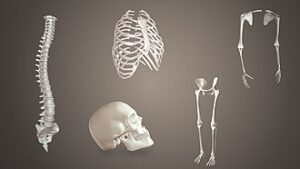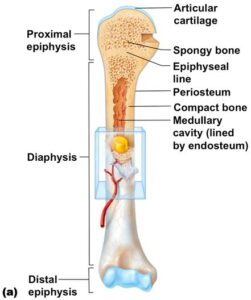Skeletal System – Bone and Muscle

1. Introduction
• The skeletal system is the framework of the body, made up of bones, cartilage, ligaments, and joints.
• It provides support, protection, movement, storage, and blood cell production.
• An adult human body has 206 bones (children have more due to unfused bones).
2.Functions of Skeletal System
• Support → gives shape and structure to the body.
• Protection → vital organs (skull protects brain, rib cage protects heart & lungs).
• Movement → bones act as levers, joints allow motion with muscles.
• Hemopoiesis (Blood cell formation) → red bone marrow produces RBCs, WBCs, platelets.
• Storage → minerals (calcium, phosphorus) and fats (in yellow marrow).
• Endocrine Role → bone cells help regulate calcium metabolism via hormones.
3. Composition of Skeletal System
• Bones → rigid, strong structures.
• Cartilage → flexible connective tissue in joints, nose, ears, trachea.
• Ligaments → connect bone to bone.
• Tendons (supporting role though muscular system) → connect muscle to bone.
• Joints → sites where two or more bones meet.
4. Classification of Bones A. By Shape
- Long Bones → femur, humerus (support, movement).
- Short Bones → carpals, tarsals (stability, limited motion).
- Flat Bones → skull, ribs, sternum (protection, muscle attachment).
- Irregular Bones → vertebrae, facial bones (specialized functions).
- Sesamoid Bones → patella (develop within tendons).
B. By Location
• Axial Skeleton (80 bones) → skull, vertebral column, rib cage.
• Appendicular Skeleton (126 bones) → upper limbs, lower limbs, pectoral & pelvic girdles.
5. Divisions of Skeletal System A. Axial Skeleton (80 bones)
- Skull (22 bones)
• Cranial (8): frontal, parietal (2), temporal (2), occipital, sphenoid, ethmoid.
• Facial (14): maxilla, mandible, zygomatic, nasal, lacrimal, palatine, vomer, inferior nasal conchae. - Hyoid Bone (1) → U-shaped, in neck, supports tongue.
- Auditory Ossicles (6) → malleus, incus, stapes in each ear.
- Vertebral Column (26 bones)
• Cervical (7), Thoracic (12), Lumbar (5), Sacrum (1), Coccyx (1). - Thoracic Cage (25 bones)
• Sternum (1), Ribs (24 → 12 pairs).
B. Appendicular Skeleton (126 bones) - Pectoral Girdle (4 bones)
• Clavicle (2), Scapula (2). - Upper Limbs (60 bones)
• Arm: Humerus (2).
• Forearm: Radius (2), Ulna (2).
• Hand: Carpals (16), Metacarpals (10), Phalanges (28). - Pelvic Girdle (2 bones)
• Hip bones (coxal bones). - Lower Limbs (60 bones)
• Thigh: Femur (2), Patella (2).
• Leg: Tibia (2), Fibula (2).
• Foot: Tarsals (14), Metatarsals (10), Phalanges (28).
6. Structure of a Long Bone

- Structure of a Long Bone
• Diaphysis (shaft): central tubular region.
• Epiphysis (ends): wider ends, contains spongy bone & red marrow.
• Metaphysis: growth plate area.
• Articular Cartilage: covers joints, reduces friction.
• Periosteum: outer membrane, rich in blood vessels/nerves.
• Medullary Cavity: central cavity with bone marrow.
• Endosteum: inner lining membrane. - Microscopic Structure of Bone
• Compact Bone (dense):
• Made of osteons (Haversian systems).
• Contains central canal, lamellae, osteocytes in lacunae, and canaliculi.
• Spongy Bone (cancellous):
• Trabeculae with spaces filled with red marrow.
• Bone Cells:
• Osteoblasts → build bone.
• Osteoclasts → break down bone.
• Osteocytes → mature bone cells.
• Bone-lining cells → regulate mineral exchange. - Joints of Skeleton
• Definition: Junction where 2 or more bones meet.
• Classification by Structure:
• Fibrous Joints: immovable (sutural joints of skull).
• Cartilaginous Joints: slightly movable (intervertebral discs).
• Synovial Joints: freely movable (knee, shoulder).
• Classification by Movement:
• Ball & Socket (hip, shoulder).
• Hinge (elbow, knee).
• Pivot (atlantoaxial joint).
• Gliding (carpals, tarsals).
• Saddle (thumb).
• Condyloid (wrist). - Development & Growth of Bones
• Ossification: Process of bone formation.
• Intramembranous (flat bones like skull).
• Endochondral (most bones via cartilage model).
• Influences: hormones (growth hormone, sex hormones, calcitonin), nutrition (calcium, vitamin D, protein), physical activity. - Applied/Nursing Aspects
• Common bone disorders:
• Fractures (simple, compound).
• Osteoporosis (reduced bone mass).
• Rickets/Osteomalacia (vitamin D deficiency).
• Arthritis (joint inflammation).
• Scoliosis/Lordosis/Kyphosis (spinal curvatures).
• Nursing Considerations:
• Immobility management.
• Pain and inflammation care.
• Prevention of falls in elderly.
• Patient education about diet and exercise. - Summary for Quick Review
• Skeleton = 206 bones.
• Two divisions: Axial (80), Appendicular (126).
• Functions = Support, Protection, Movement, Blood cell formation, Storage.
• Types of bones = Long, Short, Flat, Irregular, Sesamoid.
• Joints = Fibrous, Cartilaginous, Synovial.
• Bone health requires nutrition, hormones, and physical activity.